
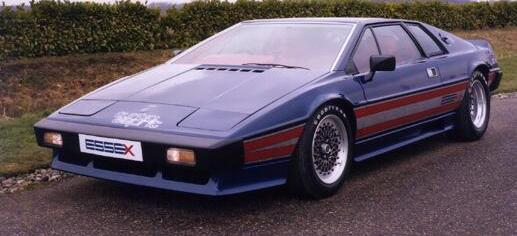
![]()
Lotus
Essex
Turbo Esprit
Lotus joined the fashionable turbo brigade, with a new Esprit Turbo which was unveiled under bright lights and expected extravagance of a party hosted by Essex Petroleum in London’s Royal Albert Hall. The new car’s birth certificate shows it to be the Essex Commemorative Lotus Esprit Turbo, production of which started in the spring of 1980 at the rate of ten a week. Only available finished in the Monte Carlo enterprise’s colours of blue, red and silver.
Though the car still carries the Esprit tag, its is effectively a new car and, apart from the competition orientated external changes, the real reason for the car’s birth comes from inside the multi-coloured exterior where the 16-valve engine has been punched out to 2,174cc, as in the Talbot Sunbeam Lotus, using a bore of 95.25mm, and stroke of 76.20mm. The four-cylinder aluminium engine provides a manufacturer’s claimed 210bhp at 6250rpm and 200lb ft of torque at 4500rpm.
A Garrett T3 turbocharger which is mounted downstream of the twin Dellorto carburetters supplies boost up to 8psi and the engine operates on a 7.5:1 compression ratio. The downstream carburetion was chosen because Lotus believed it offered the advantages of improve throttle response, better air/fuel distribution and better wet fuel handling during starting. Lotus says the engine was designed to minimise the traditional problems of throttle lag and poor low speed torque that often trouble turbo engines – the problems being overcome by reducing the volumes of both the pre-turbine exhaust system and the induction system between the compressor and inlet valve. The turbocharger lubrication is direct from the main oil gallery, with rain to the dry sump, while the peak turbine speed is a cool 110,000rpm. The current Esprit five-speed gearbox has been retained and is attached to the engine block by a new alloy bell housing, while power is transmitted via a new clutch with increased capacity to the wheels via plunging constant velocity jointed driveshaft.
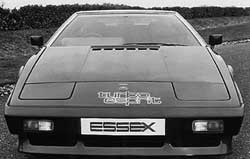
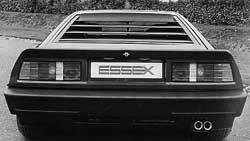
Maximum speeds in the various gears are 41.2 mph for first 62mph for second 91.1mph for third, 123.5mph for fourth and an inviting 152mph for fifth. Acceleration figures – supplied by Lotus – are 0-30 in 2.05secs, 0-40 in 2.85sec, 0-50 in 4.2secs, 0-60 in 5.55secs, 0-70 in 7.35 secs, 0-80 in 9.25 secs 0-90 in 11.185secs and 0-100 in 14.65 secs while a standing quarter-mile is offered in 14.4secs (98mph) and a standing kilometre in 26.1 secs (124mph).These are speeds comparable to cars in video arcade games of the time.
The Esprit Turbo’s backbone chassis is completely new – zinc galvanised and with a five year guarantee subject to normal use – incorporating a wider front box section and suspension mounting points. A new space frame engine and transmission section is included, giving a four point wide-based mounting system and increased houses a new full-width radiator and oil cooler with increased capacity.
The new front suspension has been adopted from the Elite, with the track increased by an inch, while the rear suspension is also revised, with unequal length transverse links with radius arms. Plunging driveshafts are used with new aluminium hub carriers, the track increased by 0.7". Ventilated brake discs were abandoned – the reason being they were found to be lacking "in feel and longevity" – in favour of a larger solid front disc than used on the Esprit S2, though the rear disc brake assembly from the S2 has been kept, but both brake master cylinder and servo have been made bigger


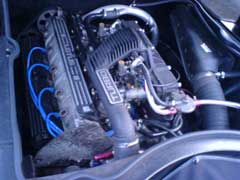
The Esprit Turbo’s appealing exterior is, like the plush interior, the work to Giorgio Guigiaro at Ital Design – Guigiaro being, of course, the stylist of the Esprit S2. Bodyshell changes include large wrap-around front and rear bumpers, a full-width fronts spoiler for better air flow to the larger radiator/oil cooler and improved aerodynamics and a redesigned tailgate area to provide direct cooling airflow. NACA ducts have been moulded into the sills to provide cooling air into the engine compartment – which because of the redesigned chassis offers better access – because of the lack of turbulence beneath the car. A distinctive rear spoiler which incorporates tail lamp and registration plate housings is used to balance the car and give high speed stability. Guigiaro has retained the Esprit’s basic cockpit configuration though several detailed changes have been make including an instrument panel which now boasts a turbo boost gauge and speedometer running up to 170mph. Air conditioning controls are now situated in a centre console panel and all switch-gear is backlit when main and side lights are illuminated. A National Panasonic stereo/cassette radio unit is a standard feature of the Esprit Turbo and built into the roof of the car – two speakers being in the bulkhead behind the driver and passenger and two in the facia below the windscreen pillars. The seats have revised foam foundations and new head restraints while the standard interior trim is "fine tone" ruche stitched leather. Road wheels are three-piece composite alloy and fitted with Goodyear’s new performance ultra low profile NCT tyre – a steel belted VR performance tyre with elliptical sidewalls, straight circumferential grooved tread pattern and open radial shoulder channels.
Dry Sump Engines
It isn't hard to properly check the oil level on the dry sump engines. I would strongly advise you NOT to simply overfill it, as this can have
serious consequences. Simply do it the way it's supposed to be done, and you'll be fine.The following is from Section EA, Page 4 of the 1980 - 1987 Service Notes for the Turbo Esprit and Esprit S3:
Dry Sump Turbo: Check the oil level in the tank at the right hand side of the engine bay WITHIN TWO MINUTES of switching off. Oil will drain back from the tank into the sump when left standing and if the level is checked before the scavenge pumps have returned this oil to the tank, overfilling will result.
Note that the capitalization above is as it appears in the service notes; I didn't add it. Basically, you just need to check the level with the oil hot - but then that's true of checking the oil in any car – and as quickly as possible after shutting off the engine. Nothing more
to it.I quote from two period road tests:
Auotocar w/e 23rd May 1981. "but more of a concern was the difficulty we had in accurately checking the engine oil level. Even by following the reccommended procedure, that is to dip the oil tank within two minutes of stopping the engine,we found alarming variations in the reading and sometimes no reading at all on the very short dipstick. The tendancy therefore was to play safe and keep the tank slightly overfull.
Motor Sport September 1981. "the oil level is difficult to assess correctly- the instructions say the level should be checked within two minutes of coming too rest, but doing this three times within 300 miles resulted in three different readings. Lotus Engineer Ken Sears on why the dry sump system was dropped "but in service, the tedium of trying to explain to customers how to check dry sump oil level – on a flat surface of course – far outweighed any theoretical service advantages. For example every variation in temperature led to a different oil level height being recalled on the dipstick, leading to understandable confusion".
I had experience of these problems with a friend who owned an Essex in the early eighties, when we found it impossible to be sure the oil level was correct due to inconsiostent readings,
Esprit Production Figures
1976-2004
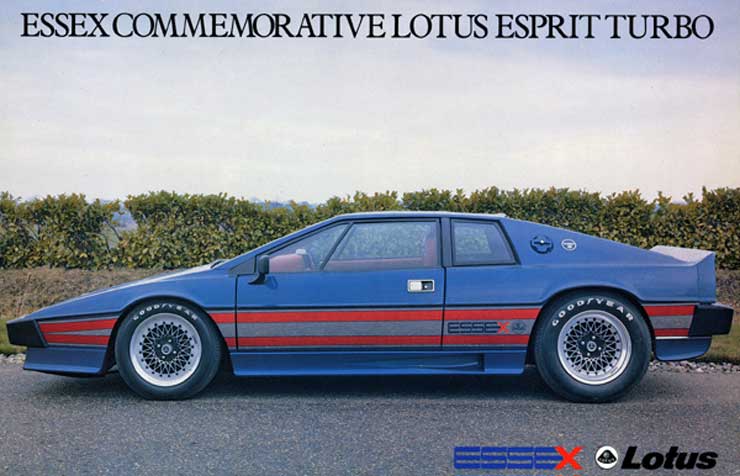
1980
LOTUS ESSEX
TURBO ESPRIT
Engine
Lotus 910 2174 cc four-cylinder in-line, 16-valve DOHC,
two Dellorto DHLA4OH side draugh carburettors.
Bore & Stroke: 95.25mm x 76.2mm. Compression: 7.5:1.
Block & Head: Aluminum alloy
Garrett AiResearch T3 Turbocharger running at 8psi
Peak Turbine Speed:
110,000rpm
Dry Sump:
Via Toothed-belt oil pump, driven at 0.69
of crankshaft rpm; two scavenge pumps
Power
and Torque
210bhp @ 6250rpm
200lb ft @ 4500rpm
Body/Chassis
Glassfibre-reinforced plastic body with galvanised steel backbone chassis.
Passenger compartment encapsulated in a 'safety-cell structure'.
Transmission
Five-speed manual unit. Rear-wheel drive.
Clutch: 9.5in diaphragm spring, hydraulically operated.
Brakes
10.5in discs front
9.7in inboard discs rear
Dual braking system, split front/rear circuits
Steering
Rack-and-pinion
Suspension
Front: Independent by upper wishbones, lower transverse links, coil springs,
anti-roll bar.
Rear: independent by non-parallel unequal-length double transverse links,
radius arms, coil springs.
Wheels & Tyres
Front: 7J x 15
Rear: 8J x 15
Goodyear Grand Prix
Front: 195/60 VR15
Rear: 235/60 VR15
Weight
1,148kg
Performance
Top speed: 150mph
0-60mph: 5.6 sec
Fuel
Consumption: 23mpg.
Tank capacity: 15 gallons
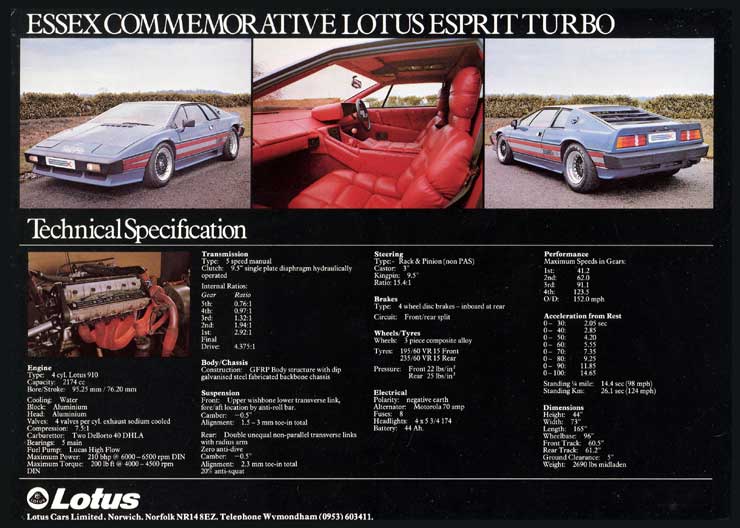
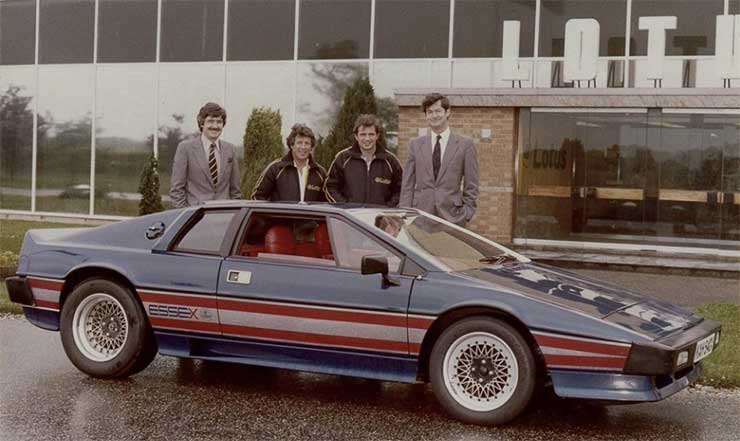
|
|